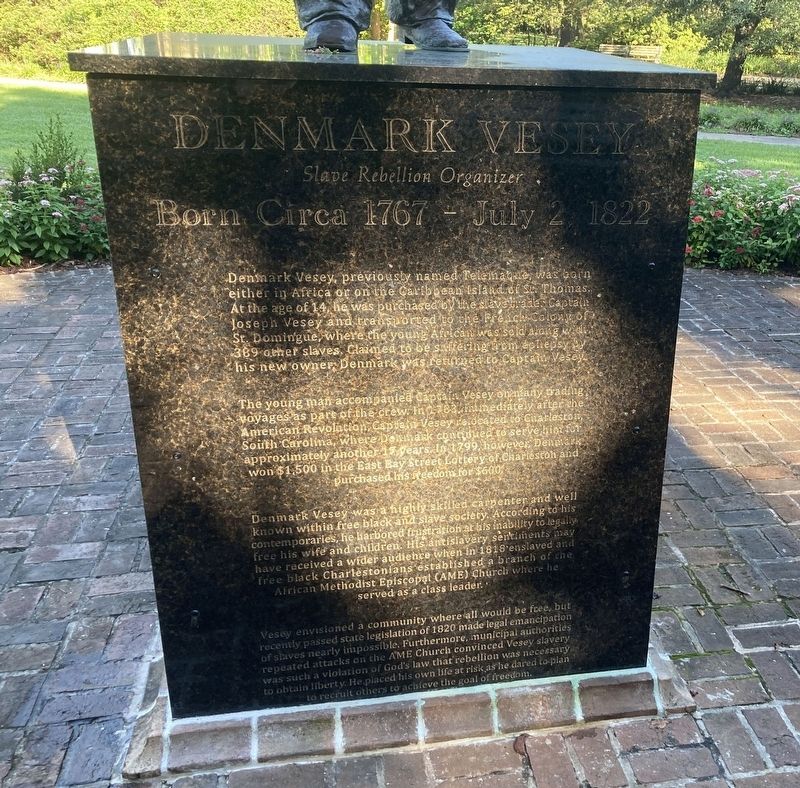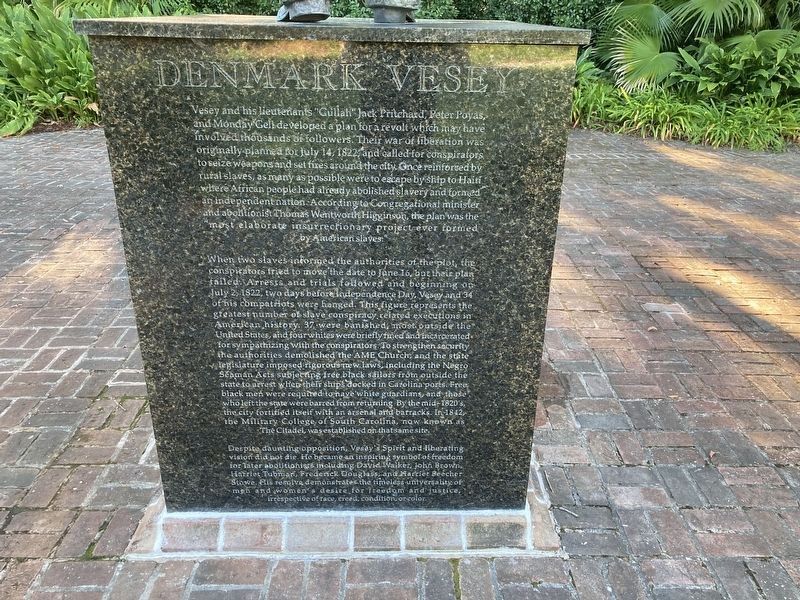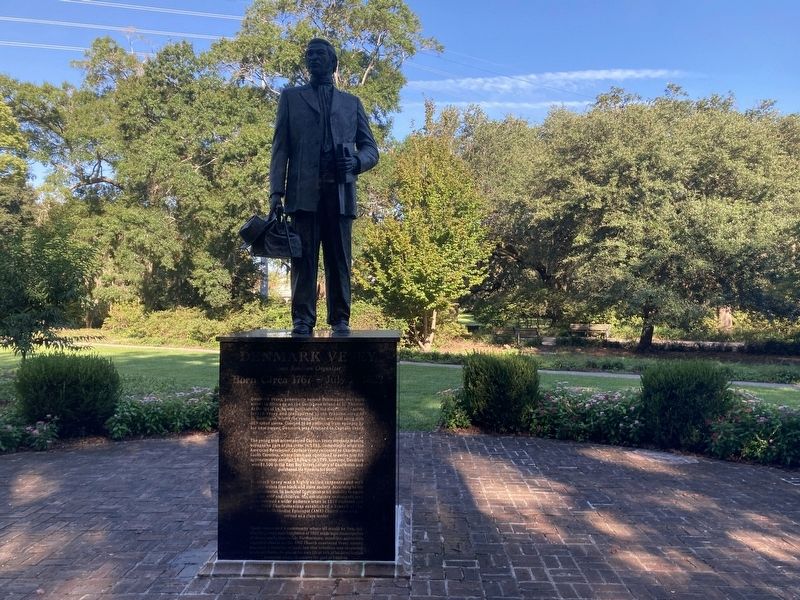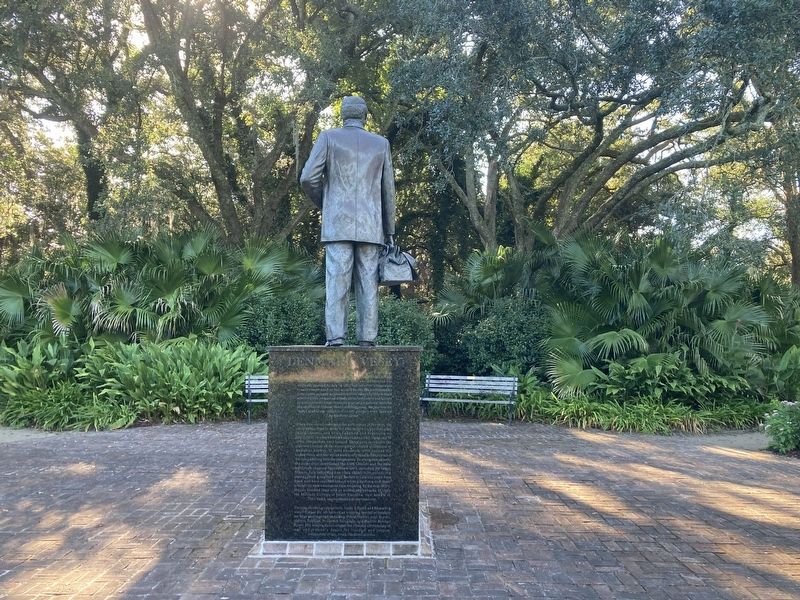Hampton Park Terrace in Charleston in Charleston County, South Carolina — The American South (South Atlantic)
Denmark Vesey
Born Circa 1767 - July 2, 1822
Denmark Vesey, previously named Telemaque, was born either in Africa or on the Caribbean island of St. Thomas. At the age of 14, he was purchased by the slave trader Captain Joseph Vesey and transported to the French Colony of St. Domingue, where the young African was sold along with 389 other slaves. Claimed to be suffering from epilepsy by his new owner, Denmark was returned to Captain Vesey.
The young man accompanied Captain Vesey on many trading voyages as part of the crew. In 1783, immediately after the American Revolution, Captain Vesey relocated to Charleston, South Carolina, where Denmark continued to serve him for approximately another 17 years. In 1799, however, Denmark won $1,500 in the East Bay Street Lottery in Charleston and purchased his freedom for $600.
Denmark Vesey was a highly skilled carpenter and well known within free black and slave society. According to his contemporaries, he harbored frustration at his inability to legally free his wife and children. His antislavery sentiments may have received a wider audience when in 1818 enslaved and free black Charlestonians established a branch of the African Methodist Episcopal (AME) Church where he served as a class leader.
Vesey envisioned a community where all would be free, but recently planned state legislation of 1820 made legal emancipation of slaves nearly impossible. Furthermore, municipal authorities repeated attacks on the AME Church convinced Vesey slavery was such a violation of God's law that rebellion was necessary to obtain liberty. He placed his own life at risk as he dared to plan to recruit others to achieve the goal of freedom.
(rear)
Vesey and his lieutenants "Gullah" Jack Pritchard, Peter Poyas, and Monday Gell developed a plan for a revolt, which may have involved thousands of followers. Their war of liberation was originally planned for July 14, 1822, and called for conspirators to seize weapons and set fires around the city. Once reinforced by rural slaves, as many as possible were to escape to Haiti where African people had already abolished slavery and formed an independent nation. According to Congregational minister and abolitionist Thomas Wentworth Higginson, the plan was "the most elaborate insurrectionary project ever formed by American slaves."
When two slaves informed the authorities of the plot, the conspirators tried to move the date to June 16, but their plan failed. Arrests and trials followed and beginning on July 2, 1822, two days before Independence Day, Vesey and 34 of his compatriots were hanged. This figure represents the greatest number of slave conspiracy related executions in American history. 37 were banished, most outside the United States, and four whites were briefly fined and incarcerated for for sympathizing with the conspirators. To strenghten security the authorities demolished the AME Church, and the state legislature imposed rigorous new laws, including the Negro Seaman Acts subjecting free black sailors from outside the state to arrest when their ships docked in Carolina ports. Free black men were required to have white guardians, and those who left the state were barred from returning. By the mid-1820's, the city fortified itself with an arsenal and barracks. In 1842, the Military College of South Carolina, now known as the The Citadel, was established on that same site.
Despite the daunting opposition, Vesey's Spirit and liberating vision did not die. He became an inspiring symbol of freedom for later abolitionists including David Walker, John Brown, Harriet Tubman, Frederick Douglass, and Harriet Beecher Stowe. His resolve demonstrates the timeless universality of men and women's desire for freedom and justice irrespective of race, creed, condition, or color.
Erected 2014.
Topics. This historical marker is listed in these topic lists: African Americans • Civil Rights. A significant historical date for this entry is July 2, 1822.
Location. 32° 48.001′ N, 79° 57.315′ W. Marker is in Charleston, South Carolina, in Charleston County. It is in Hampton Park Terrace. Marker can be reached from the intersection of Mary Murray Drive and Cleveland Street. Located in Hampton Park. Touch for map. Marker is at or near this postal address: 30 Mary Murray Dr, Charleston SC 29403, United States of America. Touch for directions.
Other nearby markers. At least 8 other markers are within walking distance of this marker. Genevieve Kanapaux McMahon (about 700 feet away, measured in a direct line); First Memorial Day (about 800 feet away); Hampton Park Terrace (approx. ¼ mile away); H.M.S. Seraph (approx. ¼ mile away); Lt. Frank Elwood Bloomenshine and Lt. James Futrell Exley (approx. 0.3 miles away); Anchor of the U.S.S. Coral Sea (approx. 0.3 miles away); Citadel Flag (approx. 0.3 miles away); CPT Christopher James Kenny (approx. 0.3 miles away). Touch for a list and map of all markers in Charleston.
Credits. This page was last revised on February 16, 2023. It was originally submitted on September 5, 2022. This page has been viewed 319 times since then and 58 times this year. Photos: 1, 2, 3, 4. submitted on September 5, 2022. • Bernard Fisher was the editor who published this page.



